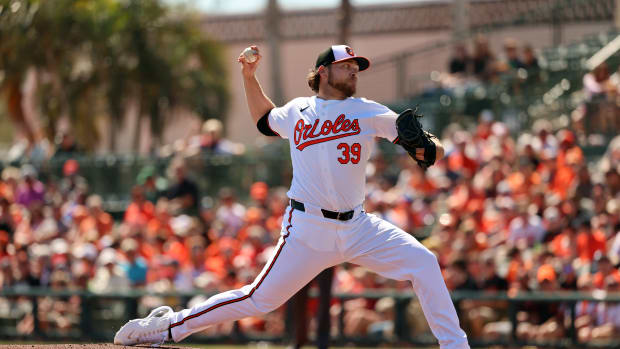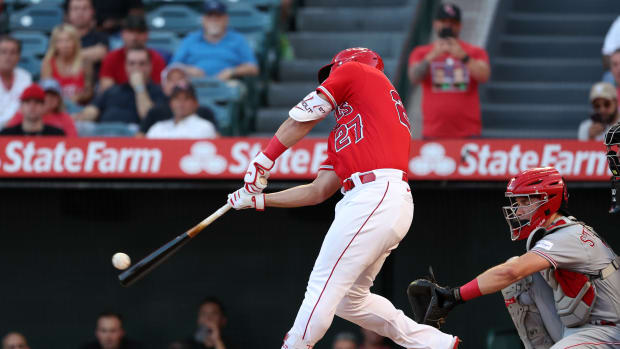
Whatever happened to the famed Moneyball draft class of 2002?
There was a time when on-base percentage was simply an afterthought. You know, when concepts like VORP and BABIP were just funny-sounding acronyms. It was back when Bill James was indiscernible from every other portly bearded man and sabermetrics sounded like some kind of advanced exercise class. It feels like this era was decades ago, especially when you see the number of stat-head general managers that are currently running franchises. But that is the impact Moneyball had on the game of baseball. Since the book's release in 2003, all of those aforementioned things seem like they've been around for centuries.
Fast forward eight years, and Brad Pitt is set to star as Oakland GM Billy Beane in a film adaptation of Michael Lewis's best-selling book. A once anonymous general manager of the Athletics who was romanticized as the book's protagonist, Beane was perceived as a baseball deity of sorts following its release. After all, he was the man who managed to put together championship contending teams year after year with a shoe-string payroll and a high-value on highly undervalued statistics. Much of the book focused on his now infamous 2002 draft class, which was hyped to eventually develop into a statistician's dream. But eight years later, how have things really worked out for Beane and that cache of first-round picks? And how has it worked out for some of the guys he infamously panned?
Nick Swisher (16th overall)
In Moneyball, Beane's unrequited love for Swisher was well-documented. Perceived to be the perfect hybrid of athletic ability and sabermetric value, Swisher was the player in the 2002 draft that Beane coveted most. The Athletics -- who tried to keep Beane away from Swisher before the draft so that other teams wouldn't know that he was interested in him -- snagged the Ohio State product with the 16th pick. Out of all of the first round picks from the infamous Moneyball draft, Swisher has arguably been the most productive major leaguer. But despite being the apple of Billy Beane's eye in 2002, Swisher spent just three full seasons in Oakland before being dealt to the White Sox for a package of players that included current A's ace Gio Gonzalez. Now 30, Swisher is the starting rightfielder of the Yankees and has hit 185 home runs and boasts an .827 career OPS, the best of any of the Moneyball picks. He also is the 2002 draftee with the most career appearances on How I Met Your Mother (one).
Joe Blanton (24th)
Blanton, taken just eight picks after Swisher, was arguably the second most productive player from Beane's 2002 haul. Considered by Oakland to be one of the draft's best starting pitchers, Beane and company were incredulous when he slipped to the 24th pick, instantly snatching him up. Like Swisher, Blanton didn't have a terribly long tenure in Oakland. After three full seasons, the right-hander was dealt to Philadelphia before the 2008 trade deadline for a trio of prospects, including Josh Outman. But with a 73-62 career record and 4.33 ERA, Blanton hasn't quite been the top of the rotation stud that the Athletics originally envisioned.
John McCurdy (26th)
"This is unfair," said Erik Kubota, Oakland's then-scouting director about the prospect of drafting Swisher, Blanton and McCurdy, a University of Maryland shortstop. Deemed the second best hitter on Beane's wish list, McCurdy was glowingly described as "an ugly-looking fielder with the highest slugging percentage in the country" and taken with Oakland's 26th pick. Despite Kubota's statements, the pick turned out to be very fair. McCurdy played just 100 of his 494 minor league games above A-ball, and never played higher than Double-A. He finished his five-year minor league career in 2006 just 33 homers and a .259/.308/.374 batting line.
Ben Fritz (30th)
Ben Fritz was the third best right-handed pitcher in the draft, according the laptop of former assistant GM Paul DePodesta. It's very possible that DePodesta's computer may have had a virus. Despite a strong start to his career (3.18 ERA in his first minor league season of 2002), Fritz never cracked the major league level. He making it as high as Triple-A in 2005 before hitting the independent circuit, where he last played professionally in 2010.
Jeremy Brown (35th)
Out of all of the Moneyball draftees, perhaps no one received as much attention as Brown, Oakland's 35th overall pick. In fact, there was an entire chapter in the book named after him ("The Jeremy Brown Blue Plate Special"). Brown was a controversial figure, seen by most teams as someone who shouldn't even be drafted. However, Beane saw him as a productive force at the plate. After all, he was a catcher who could hit and, more importantly, draw walks. Brown is also known as the guy in Moneyball who was constantly the butt of fat jokes that seemed to never end. "This kid wears a large pair of underwear," one of Oakland's scouts quipped when discussing Brown. "It's a soft body...A fleshy kind of a body," said another. Despite the criticism, Beane selected the 5'10, 210 pound Alabama product, who does have a .300 career average in the major leagues. Unfortunately, Brown only appeared in five games for Oakland, all at the end of 2006, and announced his retirement before the 2008 season.
Stephen Obenchain (37th)
Obenchain never developed into a household name after Oakland selected him with the team's second-to-last first round pick. Listed at 6'5", 220, the right-hander had a promising start in the minors, notching a 2.91 ERA at A-ball in '02 before injuries hampered his career. Obenchain made it as high as Double-A before joining the independent leagues in 2007, where he spent one year playing for both the Gary RailCats and the Evansville Otters and then retiring.
Mark Teahen (39th)
There were rumblings around the Oakland front office that Mark Teahen, a local product who played just down the road at St. Mary's College, could develop into the next Jason Giambi. He didn't flash much power in college, but the Athletics loved his approach at the plate and thought that he could develop a home run stroke. Oakland took Teahen with their 39th pick, but he would never suit up for the Athletics, having been traded to the Royals as part of a three team deal in 2004 that sent Octavio Dotel to Oakland and Carlos Beltran to Houston. Now with the Blue Jays, his third stop in the majors, Teahen has developed into a modestly productive outfielder, sporting a career average of .264, including a .290, 18 home run season in 2006. However, Teahen never developed the power that the Oakland front office hoped that he would. His seven-year total of 67 is 361 fewer than Giambi.
Prince Fielder (7th): Fielder was ridiculed in Moneyball as someone who was too fat for even the Athletics. The concept of drafting the high school slugger seemed laughable in Oakland's front office. Now, nine years later, it appears that Fielder is getting the last laugh. In just his seventh big league season, Fielder has slugged 226 homers, has 648 RBIs and is currently one of the leading candidates for NL MVP this year. Granted, the 5'11", 275-pound Fielder may not win a Miss Hawaiian Tropic contest any time soon. But it seems that the Athletics front office missed the boat with their opinion of Cecil's kid.
Jeff Francis (9th): Before the draft, Oakland made a list of all the players they would draft in a perfect world. Ultimately, they were able to snag most of those guys. But one of the highest rated pitchers on their list, a Canadian left-hander named Jeff Francis, was picked ninth by the Rockies. Francis showed flashes of promise in Denver, going 17-9 finishing ninth in the NL Cy Young balloting for a World Series-bound Rockies squad in 2007. However, the injury bug has limited Francis's career, as a torn labrum sidelined him for the entire 2009 season. In 2011, his first year outside of Coors Field, Francis has gone 6-16 with a 4.82 ERA for the Royals.
Scott Kazmir (15th): The A's didn't have "the slightest interest" in taking Scott Kazmir in the 2002 draft, even if he tumbled all the way to them at 16. In fact, it was said in Moneyball that taking a high school pitcher like Kazmir was a "not-so-bright decision." Kazmir had four very impressive years as the ace of Tampa's rotation from 2005-08, including a 2007 season when he struck out 239 as a 23-year-old. Oakland's opinion of Kazmir wasn't the only gross misjudgment of the left-hander. The Mets traded him for journeyman Victor Zambrano in 2004. After being traded again, this time to the Angels in 2009, Kazmir's career went south. He compiled a 5.31 ERA in Los Angeles before being cut and is currently unsigned.



































